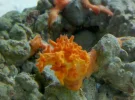the first one is an "orange carnation?"
i have never seen one before so i don't know if this one looks healthy, or if i should be concerned.. i was told to feed him phytoplankton?
the second anemone looking one, i have no clue. he eats shrimp well.. and looks healthy. im not sure what else is is on the rock with him. any guidance?
i have never seen one before so i don't know if this one looks healthy, or if i should be concerned.. i was told to feed him phytoplankton?
the second anemone looking one, i have no clue. he eats shrimp well.. and looks healthy. im not sure what else is is on the rock with him. any guidance?



